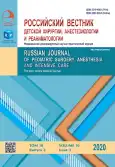Gastroenteroanastomosis using NOTES-technologies — results of an experimental study
- Authors: Smirnov A.А.1, Chernov A.V.2, Kargabaeva A.B.3, Konkina N.V.1, Baranova N.A.2, Rasputin A.A.4, Ochirov C.B.4, Cheremnov V.S.4, Kozlov Y.A.4,5
-
Affiliations:
- Pavlov First St. Petersburg State Medical University
- Veterinary Center Endovet
- Kazakh Scientific Research Institute of Oncology and Radiology Republic of Kazakhstan
- Ivano-Matreninsky Children’s Clinical Hospital
- Irkutsk State Medical University
- Issue: Vol 10, No 3 (2020)
- Pages: 275-283
- Section: Original Study Articles
- URL: https://journal-vniispk.ru/2219-4061/article/view/122922
- DOI: https://doi.org/10.17816/psaic668
- ID: 122922
Cite item
Full Text
Abstract
Introduction. Transluminal endoscopic surgery performed through natural orifices can reduce the incidence of complications associated with the surgical procedure and the incidence of postoperative complications. The purpose of this study was to determine the feasibility of performing an experimental gastroenteroanastomosis in a live pig model using NOTES.
Materials and methods. The experimental study was performed on living laboratory models — pigs weighing from 25 to 30 kg. The study’s preliminary phase allowed working out the technique using two animals removed from the experiment after its successful completion. The final phase included the implementation of gastrojejunoanastomosis in six animals with subsequent observation. In three animals, the procedure was performed with laparoscopic assistance using a single-channel video gastroscope. In the other three animals, it was performed without laparoscopy using a two-channel video gastroscope. Antibiotic therapy continued for seven days after surgery. The surviving animals were removed from the experiment after four weeks. Patency of the anastomosis was confirmed by repeated endoscopy and histological analysis of tissues.
Results. All procedures were completed successfully in six animals (three males and three females). The formation of anastomosis required an average of 133.3 ± 43.8 minutes (range, 80–200 minutes). In one animal, bleeding during gastric wall incision was recorded and was stopped by electrocoagulation. One animal died because of an anastomotic leak and peritonitis, confirmed by autopsy. In the five surviving animals, repeated endoscopy demonstrated fully passable anastomoses covered by the mucosa.
Conclusion. Gastrojejunal anastomosis using NOTES technology is technically possible but requires additional study.
Keywords
Full Text
##article.viewOnOriginalSite##About the authors
Aleksandr А. Smirnov
Pavlov First St. Petersburg State Medical University
Email: smirnov-1958@yandex.ru
Сand. Sci. (Med.), Associate Professor of the Department of Hospital Surgery No. 2, Head of the Department of Endoscopy
Russian Federation, Saint PetersburgAlexander V. Chernov
Veterinary Center Endovet
Email: chernov-av@inbox.ru
Cand. Sci. (Vet.), Head.
Russian Federation, KurganAsem B. Kargabaeva
Kazakh Scientific Research Institute of Oncology and Radiology Republic of Kazakhstan
Email: assem_doc@mail.ru
Endoscopist
Kazakhstan, AlmatyNadezhda V. Konkina
Pavlov First St. Petersburg State Medical University
Email: n_konkina@inbox.ru
Clinical resident
Russian Federation, Saint PetersburgNatalya A. Baranova
Veterinary Center Endovet
Author for correspondence.
Email: vetcenter45@mail.ru
anesthesiologist-resuscitator
Russian Federation, KurganAndrey A. Rasputin
Ivano-Matreninsky Children’s Clinical Hospital
Email: arasputin@mail.ru
ORCID iD: 0000-0002-5690-790X
Surgeon of Department of Neonatal Surgery
Russian Federation, IrkutskChimit B. Ochirov
Ivano-Matreninsky Children’s Clinical Hospital
Email: Chimitbator@gmail.com
ORCID iD: 0000-0002-6045-1087
Surgeon of Department of Neonatal Surgery
Russian Federation, IrkutskVladislav S. Cheremnov
Ivano-Matreninsky Children’s Clinical Hospital
Email: chervl@mail.ru
ORCID iD: 0000-0001-6135-4054
Clinical Ordinator of Department of Pediatric Surgery
Russian Federation, IrkutskYury A. Kozlov
Ivano-Matreninsky Children’s Clinical Hospital; Irkutsk State Medical University
Email: yuriherz@hotmail.com
Head of Department of Neonatal Surgery; Professor of the Department of Pediatric Surgery
Russian Federation, IrkutskSupplementary files









